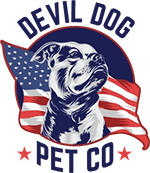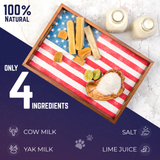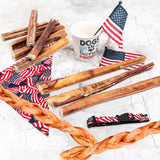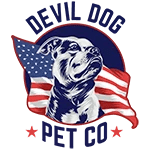Walk into any pet store and you'll find aisles packed with synthetic chews, rawhides, and processed treats. But here's what they don't tell you: your dog's ancestors didn't gnaw on manufactured products—they crushed raw bones for dogs to survive and thrive.
Key Takeaways
- Raw bones can be safe and beneficial for dogs when properly selected and fed.
- Edible raw bones provide nutritional and dental benefits, while recreational bones offer mental enrichment.
- Cooked bones should never be given to dogs due to safety risks.
- Always supervise your dog when feeding raw bones and choose bones of appropriate size.
- Consult your veterinarian before introducing raw bones into your dog's diet, starting with softer options.
Table of Contents
- What Are Raw Bones for Dogs?
- Types of Raw Bones: Your Complete Selection Guide
- Science-Backed Benefits of Feeding Raw Bones
- Safety Precautions: How to Feed Raw Bones Responsibly
- Sourcing and Storing Raw Bones: Quality Matters
- Troubleshooting: Problems and Solutions
- Separating Myths from Facts
- Making the Right Choice for Your Dog
As a Marine Corps veteran who's seen what happens when you cut corners on essentials, I'm going to give you the unfiltered truth about raw bones. Done right, they're nutritional powerhouses that clean teeth, strengthen jaws, and satisfy deep-rooted instincts. Done wrong, they can land you in the emergency vet clinic with a four-figure bill and a scared pup.
The controversy around raw dog bones isn't about whether dogs should chew bones—it's about which bones, how often, and under what conditions. Every week, we hear from Devil Dog customers asking whether they should ditch the processed chews for fresh options from their local butcher. The answer isn't simple, but it's not rocket science either.
Our dog Dexter taught us early that not all chews are created equal. After watching him demolish expensive synthetic toys in minutes while working a single raw meaty bone for hours, we realized we'd been overthinking the obvious. Dogs are designed to process bone—their digestive systems, jaw structure, and behavioral needs all point to one conclusion: the right raw bones aren't just safe, they're essential.
But "right" is the operative word here. The difference between a beneficial bone and a dangerous one often comes down to preparation, selection, and supervision. This isn't about following the latest pet food trend—it's about understanding what your dog's body actually needs and how to deliver it safely.
What Are Raw Bones for Dogs?
Before we dive into the how-to, let's establish exactly what we're talking about. Not all bones are raw bones, and not all raw bones serve the same purpose. Understanding these distinctions will keep your dog safe and maximize the benefits.
Raw Meaty Bones (RMBs): The Nutritional Powerhouses
Raw meaty bones for dogs are exactly what they sound like—uncooked bones with meat, cartilage, fat, and connective tissue still attached. Think chicken necks, duck wings, lamb ribs, or pork shoulder bones. These aren't just chew toys; they're complete nutritional packages that dogs can consume entirely.
The key word here is "consume." Unlike recreational bones, RMBs are meant to be eaten, not just gnawed. Your dog's powerful digestive acids—roughly 10 times stronger than ours—break down the bone matrix completely when the bones are appropriately sized and fresh.
Recreational Bones: The Mental Workout
Recreational bones are the marathon chews of the bone world. These are typically large, dense bones from weight-bearing joints—think beef bone for dogs like knuckle bones, femur sections, or marrow bones. The goal isn't consumption; it's mental stimulation and dental maintenance.
A properly selected recreational bone will keep your dog engaged for 30-60 minutes, scraping away plaque while providing the deep satisfaction that comes from working for their reward. Our customers often report that a single session with a quality marrow bone can calm an anxious dog for hours afterward.
The Critical Difference: Raw vs. Cooked
Here's where many dog owners get it wrong, and it's a mistake that can be fatal. Cooked bones are never safe for dogs. The cooking process fundamentally changes the bone's structure, making it brittle and prone to splintering into sharp fragments that can perforate your dog's digestive tract.
Raw bones maintain their natural flexibility and density. When your dog's saliva and digestive acids work on a fresh bone, it softens gradually and breaks down into manageable pieces. This is how wild canids have processed bones for thousands of years—and why your dog's system is designed to handle them.
The moment you apply heat to a bone, whether through boiling, baking, or grilling, you're creating a potential weapon. Those beautiful, clean white bones you see in pet stores? They've been processed and bleached beyond recognition. Stick with fresh, uncooked options from reputable sources.
Types of Raw Bones: Your Complete Selection Guide

Not all raw bones for dogs are created equal. The source animal, bone density, and intended use determine which bones belong in your dog's rotation. Here's your field guide to making smart choices.
Poultry Bones: The Beginner-Friendly Option
Chicken, duck, and turkey bones represent the gateway into raw feeding. These bones are softer, more digestible, and less likely to cause dental damage than their mammalian counterparts. Fresh bones for dogs from poultry sources include necks, backs, wings, and feet—each offering unique benefits.
Chicken necks are the gold standard for dogs new to raw bones. They're small enough for controlled consumption, rich in cartilage for joint health, and provide an excellent calcium-to-phosphorus ratio. Duck feet might look strange, but they're collagen bombs that support skin, coat, and joint health.
The softer structure of poultry bones makes them ideal for puppies transitioning to adult teeth, senior dogs with dental wear, or any dog whose owner wants to test the waters before moving to denser options.
Mammalian Bones: The Heavy-Duty Chews
When you're ready to graduate to the big leagues, cow bones for dogs and other mammalian options provide serious chewing satisfaction. Beef knuckle bones, lamb ribs, pork neck bones, and goat bones offer varying degrees of density and fat content.
Raw beef bones for dogs from the knuckle or marrow sections are recreational powerhouses. These dense bones can occupy a determined chewer for extended periods while providing access to nutrient-rich marrow. However, their hardness means they're not suitable for every dog—aggressive chewers who attack bones straight-on can fracture teeth.
Lamb and pork bones sit in the middle ground. They're denser than poultry but softer than beef, making them excellent choices for medium to large dogs who've mastered poultry bones but aren't ready for the hardest options.
Game Meat Bones: The Premium Choice
Venison, elk, and other game bones represent the premium tier of raw bone feeding. These bones typically come from wild or ethically raised animals with superior nutrition profiles. The bone density varies by species and cut, but most game bones offer excellent mineral content and unique flavor profiles that dogs find irresistible.
Game bones are often available through specialty butchers or hunting connections. If you have access to fresh game bones, they can provide variety and nutrition that commercial options can't match. Just ensure they're from healthy animals and properly handled from harvest to bowl.
Science-Backed Benefits of Feeding Raw Bones
The benefits of raw bones for dogs extend far beyond satisfying your pup's chewing instincts. When fed properly, these natural chews deliver measurable improvements in dental health, nutrition, and behavioral well-being. Let's break down what the research actually shows.
Complete Nutritional Packages
Raw meaty bones for dogs aren't just treats—they're complete food sources that wild canids have relied on for millennia. A single chicken neck provides bioavailable calcium, phosphorus, protein, and essential fatty acids in ratios that synthetic supplements struggle to match.
The calcium-to-phosphorus ratio in most raw bones sits between 1.2:1 and 2:1, which aligns perfectly with canine nutritional requirements. Compare this to many commercial dog foods that rely on synthetic calcium carbonate and you'll understand why raw feeders report stronger bones and better dental health in their dogs.
But it's not just about macronutrients. Raw meat bones for dogs deliver glucosamine and chondroitin naturally embedded in cartilage and connective tissue. These joint-supporting compounds are more bioavailable than their synthetic counterparts because they come packaged with the cofactors and enzymes needed for proper absorption.
Dental Health: Nature's Toothbrush
The mechanical action of gnawing raw dog bones provides dental benefits that no synthetic chew can replicate. As your dog works the bone, the fibrous meat scrapes away soft plaque while the bone itself polishes tooth surfaces and stimulates healthy gum circulation.
Veterinary studies consistently show that dogs fed raw bones have significantly less tartar buildup and healthier gums compared to kibble-only dogs. The key is the extended chewing time—while a dog might demolish a bully stick in 20 minutes, a properly sized recreational bone can provide 45-60 minutes of active dental cleaning.
Unlike processed chews that can become soft and sticky when wet, raw bones maintain their structure throughout the chewing session. This means consistent plaque removal from the gumline to the tip of each tooth, especially the back molars that traditional brushing often misses.
Mental Stimulation and Behavioral Benefits
The behavioral benefits of beef bone for dogs and other raw options go deeper than simple entertainment. Working a challenging bone triggers the release of endorphins and provides the deep satisfaction that comes from completing a natural behavior sequence.
Dogs who regularly receive appropriate raw bones show reduced anxiety, decreased destructive behaviors, and improved focus during training sessions. The mental effort required to extract marrow and strip meat provides cognitive stimulation that can tire a dog as effectively as a long walk.
For high-drive working breeds, raw bones offer an outlet for natural prey-drive behaviors in a controlled, safe environment. Instead of channeling that energy into your furniture or shoes, your dog can satisfy those instincts with something designed for the job.
Safety Precautions: How to Feed Raw Bones Responsibly

The difference between beneficial bone feeding and a veterinary emergency often comes down to preparation, selection, and supervision. Here's your comprehensive safety protocol for feeding raw bones for dogs without the risks.
The Non-Negotiable Safety Rules
First and most critical: never feed cooked bones. This rule has no exceptions. Cooked bones become brittle and splinter into sharp fragments that can perforate your dog's digestive tract. Whether it's a leftover steak bone or a "smoked" bone from the pet store, heat-treated bones are off-limits.
Second: supervision is mandatory for recreational bones. While raw meaty bones for dogs can often be consumed safely without constant watching, large marrow bones and knuckle bones require your presence. Set a timer for 45-60 minutes and remove the bone when the session ends.
Third: size appropriately for safety, not convenience. The bone should be large enough that your dog cannot fit it entirely in their mouth, but not so large that they attempt to swallow dangerous chunks. For most dogs, this means bones roughly the size of their head for recreational chewing.
Safe Raw Bone Practices
- Fresh, uncooked bones from reputable sources
- Appropriate sizing for your dog's mouth and chewing style
- Supervised chewing sessions with time limits
- Gradual introduction starting with softer options
- Proper storage and handling to prevent bacterial growth
Dangerous Practices to Avoid
- Any cooked, smoked, or heat-treated bones
- Bones small enough to swallow whole
- Weight-bearing bones for aggressive chewers
- Leaving dogs unsupervised with recreational bones
- Feeding bones to dogs with known dental issues
Matching Bone Type to Dog Profile
Not every dog is a candidate for every type of raw bone. Raw bones for small dogs require different considerations than bones for large breeds, and individual chewing styles matter more than breed generalizations.
Gentle chewers can handle softer options like chicken necks and duck wings regardless of size. These dogs work bones methodically, making them ideal candidates for consumable raw meaty bones for dogs. Power chewers need denser recreational bones but require careful monitoring to prevent tooth fractures from aggressive straight-down biting.
Dogs with sensitive stomachs should start with leaner options like chicken or turkey bones before progressing to richer choices like lamb or pork. The higher fat content in mammalian bones can trigger digestive upset in dogs not accustomed to rich foods.
Proper Preparation and Feeding Protocol
Thaw frozen bones completely before serving—partially frozen bones can damage teeth and don't provide the same digestive benefits. Feed bones at room temperature in a controlled environment where cleanup is manageable.
For dogs new to raw bones, start with 15-20 minute sessions every few days. Monitor stool consistency and adjust frequency based on your dog's response. White, chalky stools indicate too much bone consumption; reduce frequency or switch to meatier options.
Remove and discard bones once they become small enough to swallow whole or develop sharp edges from wear. A bone that was safe at the beginning of a session can become dangerous as it's consumed, so stay alert throughout the process.
Sourcing and Storing Raw Bones: Quality Matters
The quality of your raw bones for dogs starts with sourcing. Not all bones are created equal, and where you buy them can mean the difference between a nutritious treat and a potential health hazard.
Where to Buy Raw Bones for Dogs
Your local butcher represents your best bet for fresh, high-quality bones from butcher for dogs. Butchers can tell you exactly where their meat comes from, how long bones have been stored, and can often cut bones to your specifications. Build a relationship with your butcher—they'll often save the best bones for regular customers.
Specialty raw pet food suppliers offer convenience and variety but at premium prices. These suppliers typically source from the same distributors as butchers but add markup for the pet market. The advantage is consistent availability and bones cut specifically for dogs.
Avoid grocery store bones unless you can verify freshness and source. Those pre-packaged "soup bones" may have been sitting in cold storage for weeks and often come from factory farming operations with questionable practices.
Storage and Handling Best Practices
Fresh raw beef bones for dogs and other raw bones should be used within 2-3 days of purchase or frozen immediately. Freeze bones individually in freezer bags to prevent them from sticking together, and label with the date and type.
Thaw bones in the refrigerator, never at room temperature. This prevents bacterial growth while ensuring even thawing. Once thawed, use within 24 hours and never refreeze.
Practice strict hygiene when handling raw bones. Wash hands thoroughly before and after handling, sanitize surfaces that contact the bones, and keep raw bones separate from human food preparation areas.
The investment in quality sourcing and proper storage pays dividends in your dog's health and your peace of mind. A few extra dollars spent on premium bones from trusted sources beats a veterinary emergency bill every time.
Troubleshooting: Problems and Solutions

Even with perfect preparation, feeding raw bones for dogs can present challenges. Knowing how to recognize and address common issues quickly can mean the difference between a minor adjustment and a veterinary emergency.
Managing Digestive Upset
White, chalky stools are the most common sign that your dog is consuming too much bone relative to meat. This calcium overload typically resolves within 24-48 hours, but you need to adjust your feeding protocol immediately. Reduce bone frequency by half and choose meatier options like chicken thighs over bare knuckle bones.
Constipation from raw meaty bones for dogs usually indicates portion size issues rather than bone type problems. Dogs new to raw bones often struggle with the rich, dense nutrition. Start with smaller bones and shorter chewing sessions, gradually building up as their digestive system adapts.
Loose stools, while less common, can occur when dogs consume too much rich marrow or fatty tissue. Switch to leaner bone options like turkey necks or chicken backs until stools firm up, then slowly reintroduce richer choices.
Addressing Resource Guarding and Aggression
High-value items like beef bone for dogs can trigger resource guarding behaviors even in previously gentle dogs. If your dog becomes possessive over bones, don't attempt to remove the bone directly. Instead, trade up with an even higher-value item like fresh meat or a special treat.
Practice "bone manners" by requiring your dog to sit and wait before receiving their bone. Randomly approach during chewing sessions to drop treats nearby, teaching your dog that human presence near their bone means good things happen, not bone removal.
For dogs with established guarding issues, work with a certified dog trainer before introducing raw bones. The intensity of the chewing experience can escalate existing behavioral problems if not managed properly.
Preventing and Managing Dental Issues
Tooth fractures from raw bones are preventable with proper bone selection and supervision. Dogs that bite straight down with full force on hard bones risk cracking their carnassial teeth. Encourage side-gnawing by holding one end of the bone initially, rewarding your dog when they work it from the side.
If you notice your dog's teeth becoming worn or developing sharp edges, switch to softer bone options or reduce chewing frequency. Senior dogs and those with existing dental work need especially careful monitoring when consuming any hard chew.
Gum irritation can occur when dogs work particularly tough bones for extended periods. Limit initial sessions to 20-30 minutes and gradually increase as your dog's mouth toughens up. Fresh raw bones for small dogs should be proportionally softer than those offered to large breeds.
Separating Myths from Facts
The controversy surrounding raw bones for dogs has generated numerous misconceptions that prevent many dog owners from safely incorporating this natural nutrition source into their pet's diet.
Myth: All Bones Splinter and Are Dangerous
This myth stems from legitimate concerns about cooked bones, but raw bones behave completely differently. Fresh, uncooked bones maintain their natural flexibility and collagen content, making them bend and compress rather than shatter into sharp fragments.
The splintering danger applies specifically to heat-treated bones—whether boiled, baked, smoked, or grilled. Heat removes moisture and breaks down the collagen matrix that gives bones their flexibility. Raw dog bones from reputable sources pose minimal splintering risk when sized and supervised appropriately.
Weight-bearing bones from large animals (like beef femurs) can present challenges for aggressive chewers, but this is about hardness and tooth protection, not splintering. These bones typically wear down gradually rather than breaking apart.
Fact: Proper Handling Minimizes Bacterial Risk
Raw bones do carry bacteria—just like any raw meat product. However, dogs' digestive systems are designed to handle bacterial loads that would make humans sick. Their stomach acid is significantly more acidic than ours, and their shorter digestive transit time limits bacterial multiplication.
The key is source quality and handling hygiene. Fresh bones for dogs from reputable suppliers pose no greater bacterial risk than the raw meat many dog owners already feed. Practice the same food safety measures you'd use for any raw protein: clean surfaces, wash hands, and store properly.
Immunocompromised dogs or those on antibiotics may need extra precautions, but healthy adult dogs handle raw bone bacteria without issues in the vast majority of cases.
Understanding Real Choking and Obstruction Risks
Choking incidents with raw bones typically involve improper sizing or lack of supervision rather than inherent bone danger. Dogs don't usually attempt to swallow appropriately sized bones whole—the choking risk comes from small fragments or bones that become worn down during extended chewing sessions.
Intestinal obstructions from raw bones are extremely rare compared to obstructions from tennis balls, socks, or other non-food items dogs commonly swallow. Raw meaty bones for dogs are designed to be consumed and digested, unlike synthetic chews that can form indigestible masses.
The solution isn't avoiding bones entirely—it's choosing appropriate sizes, supervising consumption, and removing bones when they become small enough to present risks. For more on safe alternatives, see our antler dog chews collection.
Making the Right Choice for Your Dog
The decision to feed raw bones for dogs shouldn't be made lightly, but it shouldn't be avoided out of unfounded fear either. Like any significant dietary change, success depends on education, preparation, and consistent application of safety protocols.
Start conservatively with softer, smaller bones and gradually work up to more challenging options as both you and your dog gain experience. Every dog responds differently to raw bones—some take to them immediately while others need weeks to adjust. Pay attention to your individual dog's reactions and adjust accordingly.
The benefits of properly managed raw bone feeding—improved dental health, better nutrition, and enhanced mental stimulation—make the learning curve worthwhile for most dogs and owners. But these benefits only materialize when bones are sourced responsibly, sized appropriately, and supervised consistently.
Consider starting with a consultation with a veterinarian familiar with raw feeding practices. They can help you assess your dog's individual risk factors and develop a feeding plan that maximizes benefits while minimizing risks. For additional guidance, check out are antlers for dogs a good idea.
Remember that raw bones for dogs are tools for health and enrichment, not just treats. When integrated thoughtfully into your dog's routine, they become part of a comprehensive approach to canine wellness that honors your dog's natural instincts while keeping them safe and healthy.
The key to success lies in taking full responsibility for every aspect of the process—from sourcing and storage to supervision and cleanup. That's what Extreme Dog Leadership demands: complete ownership of your dog's wellbeing, backed by knowledge, preparation, and unwavering attention to safety. For more information on bone safety, see this AKC guide on dogs and bones.
Download the FREE 10-Step Dog Prep Guide
**Frequently Asked Questions
What raw bones are safe for dogs?
Safe raw bones are typically large, weight-bearing bones from beef or bison that are dense and less likely to splinter, such as femurs or knuckles. Avoid cooked bones, small bones, or poultry bones, which can splinter and cause choking or internal damage. Always size bones larger than your dog’s mouth to prevent swallowing whole pieces, and supervise chewing sessions closely.
Can I give my dog raw bones from the butcher?
Yes, you can give raw bones from a trusted butcher as long as they are fresh, raw, and appropriate in size and type for your dog. Avoid cooked bones, which become brittle and dangerous. Before offering, confirm the bone is large enough to prevent swallowing whole and free of sharp edges. Consult your vet if you’re unsure about specific bones or your dog’s chewing habits.
Do vets recommend raw bones?
Veterinary opinions on raw bones vary; some support raw bones for dental health and mental enrichment if handled safely, while others caution against risks like tooth fractures, choking, or bacterial contamination. The key is responsible ownership: sourcing clean, appropriately sized raw bones, supervising chewing, and monitoring your dog’s dental and digestive health throughout.
What bones can you add to raw dog food?
When adding bones to raw dog food, focus on raw, meaty bones like beef or bison femurs, ribs, or neck bones that provide calcium and phosphorus. These should be appropriately sized to prevent choking and never cooked. Balance the bone content to about 10-15% of the total diet to meet nutritional needs while avoiding excess calcium, which can harm developing bones or kidneys.
How often should you give a dog a raw bone?
Frequency depends on your dog’s size, chew style, and nutritional needs, but generally offering a raw bone 1–2 times per week is safe and effective for dental health and enrichment. Rotate bone types and monitor wear and digestion closely. Avoid daily bones to prevent overconsumption of calcium and reduce risk of dental injury.
Are antlers safe for dogs?
Yes—grade-A, naturally shed elk antlers are safe for most adult dogs when sized correctly and supervised. Antlers are extremely hard and durable, offering long-lasting enrichment and dental benefits. However, power chewers who bite straight down risk tooth fractures, so monitor chewing style and retire the antler once it becomes small enough to swallow or shows cracks.






